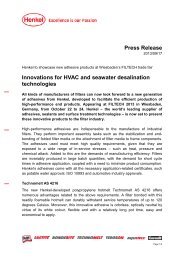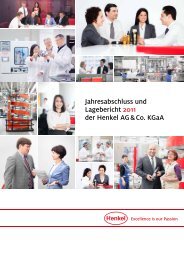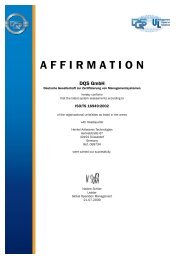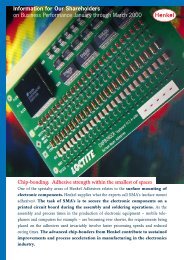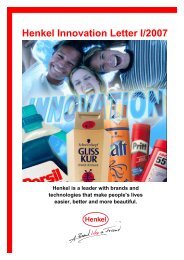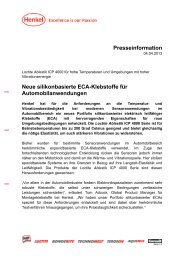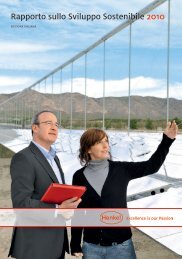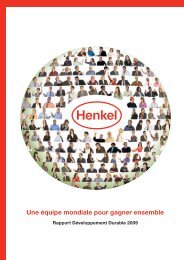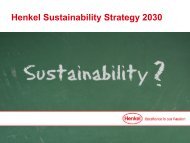Henkel Annual Report 2011 - Henkel AG & Co. KGaA Annual Report ...
Henkel Annual Report 2011 - Henkel AG & Co. KGaA Annual Report ...
Henkel Annual Report 2011 - Henkel AG & Co. KGaA Annual Report ...
You also want an ePaper? Increase the reach of your titles
YUMPU automatically turns print PDFs into web optimized ePapers that Google loves.
<strong>Henkel</strong> <strong>Annual</strong> <strong>Report</strong> <strong>2011</strong><br />
Cash flow hedges<br />
(after tax)<br />
Initial Addition Disposal End<br />
balance (recognized (recognized balance<br />
in equity) through pro-<br />
in million euros<br />
fit or loss)<br />
<strong>2011</strong> –351 4 – –347<br />
2010 – 276 – 75 – – 351<br />
The initial value of the cash flow hedges recognized in equity<br />
reflects firstly the fair values of the payer interest swaps used<br />
to hedge the cash flow risks arising from floatinginterest US<br />
dollar liabilities at <strong>Henkel</strong> of America, Inc., and secondly forward<br />
exchange contracts taken out in previous years in the<br />
course of the acquisition of the National Starch businesses.<br />
The addition in the amount of 4 million euros after taxes on<br />
income relates to the interest rate hedge of the US dollar<br />
liabilities of <strong>Henkel</strong> of America, Inc. The fair value of interest<br />
rate swaps for the US dollar liabilities of <strong>Henkel</strong> of America,<br />
Inc. amounts to –50 million euros (previous year: –69 million<br />
euros) excluding accrued interest. In the fiscal year under<br />
review, ineffective portions amounting to 0.2 million euros<br />
(previous year: 0.4 million euros) were recognized in profit or<br />
loss under financial result. The cash flows arising from hedging<br />
the floating interest rate of the US dollar liabilities of <strong>Henkel</strong><br />
of America, Inc. are expected in the period from 2012 to 2014<br />
and will be recognized through profit or loss in the periods<br />
concerned as interest expense. The hedged cash flows relating<br />
to the acquisition of the National Starch businesses will only<br />
be recognized in operating profit with disposal or in the<br />
event of an impairment loss on the goodwill attributable<br />
to the acquisition of these businesses.<br />
Hedges of a net investment in a foreign entity: The accounting<br />
treatment of hedges in a net investment in a foreign entity<br />
against translation risk is similar to that applied to cash flow<br />
hedges. The gain or loss arising from the effective portion<br />
of the hedging instrument is recognized in equity through<br />
other comprehensive income; the gain or loss of the ineffective<br />
portion is recognized directly through profit or loss. The gains<br />
or losses recognized directly in equity remain there until<br />
disposal or partial disposal of the net investment.<br />
The items recognized in equity relate to translation risks<br />
arising from net investments in Swiss francs (CHF) and US<br />
dollars (USD) for which the associated hedges were entered<br />
into and settled in previous years.<br />
<strong>Co</strong>nsolidated financial statements<br />
Notes to the consolidated statement of financial position<br />
In the past financial year, no hedges of a net investment in a<br />
foreign entity were entered into. No amounts were transferred<br />
in the course of the year from equity to profit or loss.<br />
Hedges of a net investment in a foreign entity<br />
(after tax)<br />
Initial Addition Disposal End<br />
balance (recognized (recognized balance<br />
in equity) through pro-<br />
in million euros<br />
fit or loss)<br />
<strong>2011</strong> 69 – – 69<br />
2010 53 16 – 69<br />
Risks arising from financial instruments, and risk management<br />
As a globally active corporation, <strong>Henkel</strong> is exposed in the<br />
course of its ordinary business operations to credit risks,<br />
liquidity risks and market risks (currency translation, interest<br />
rate and commodity price risks). The purpose of financial<br />
risk management is to restrict the exposure arising from<br />
operating activities through the use of selective derivative<br />
and nonderivative hedges. <strong>Henkel</strong> uses derivative financial<br />
instruments exclusively for the purposes of risk management.<br />
Without these instruments, <strong>Henkel</strong> would be exposed to<br />
higher financial risks. Changes in exchange rates, interest<br />
rates or commodity prices can lead to significant fluctuations<br />
in the fair values of the derivatives used. These variations in<br />
fair value should not be regarded in isolation from the hedged<br />
items, as derivatives and the underlying constitute a unit in<br />
terms of forex countervalue fluctuation.<br />
Management of currency, interest rate and liquidity risks is<br />
based on the treasury guidelines introduced by the Management<br />
Board, which are binding on the entire corporation. Defined<br />
in these are the targets, principles, accountability and competences<br />
of <strong>Co</strong>rporate Treasury. They describe the fields of<br />
responsibility and establish the distribution of these responsibilities<br />
between the <strong>Co</strong>rporate Treasury department and<br />
<strong>Henkel</strong>’s subsidiaries. The Management Board is regularly and<br />
comprehensively informed of all major risks and of all relevant<br />
hedging transactions and arrangements. The objectives<br />
and fundamental principles adopted in capital management<br />
are described in the Management <strong>Report</strong> on pages 62 and 63.<br />
There were no major risk clusters in the year under review.<br />
133



